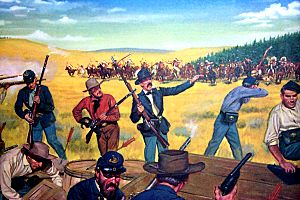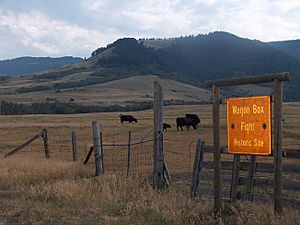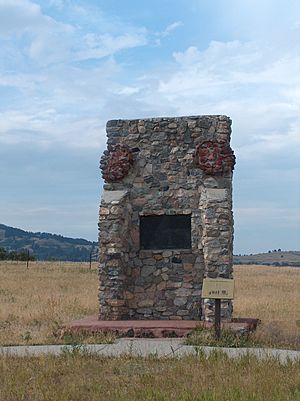Wagon Box Fight facts for kids
Quick facts for kids Wagon Box Fight |
|||||||
|---|---|---|---|---|---|---|---|
| Part of Red Cloud's War | |||||||
 An illustration of the engagement |
|||||||
|
|||||||
| Belligerents | |||||||
| Lakota Sioux | |||||||
| Commanders and leaders | |||||||
| Red Cloud Crazy Horse High Backbone |
|||||||
| Strength | |||||||
| 26 soldiers 6 civilians |
300–1,000 warriors | ||||||
| Casualties and losses | |||||||
| 7 killed 2 wounded |
~6 killed 6 wounded |
||||||
The Wagon Box Fight happened on August 2, 1867. It was a battle during Red Cloud's War near Fort Phil Kearny in Wyoming. A small group of 26 U.S. Army soldiers and 6 civilians were attacked. They faced hundreds of Lakota Sioux warriors.
Even though they were greatly outnumbered, the soldiers had a big advantage. They used new, fast-firing rifles. They also had a strong defensive wall made from wagon boxes. This helped them hold off the attackers for hours. They had few casualties, but lost many horses and mules. This was the last major battle of Red Cloud's War. The area is now a Wyoming State Historic Site.
Why the Fight Happened
In July 1867, Lakota warriors, led by Red Cloud, decided to attack U.S. forts. They wanted to follow up on their wins from the year before. The warriors split into two groups. One group went towards Fort C.F. Smith. The other, including Red Cloud, headed for Fort Phil Kearny.
Soldiers at Fort Phil Kearny had two main jobs. They guarded travelers on the Bozeman Trail. They also gathered wood and hay for the fort. These tasks were done by civilian workers, protected by soldiers. Native American warriors often attacked these groups. They killed soldiers and civilians and took their livestock.
At first, the soldiers had old, slow-loading guns. But they recently got new rifles. These new guns could fire three times faster. They were also easier to reload while lying down. The Native American warriors mostly used bows and arrows. These were good for quick attacks. But they were not effective against enemies hiding behind strong defenses.
To protect the woodcutters, a special corral was built. It was made from 14 wagon bodies. These were taken off their wheels and placed in an oval shape. Soldiers and civilians could hide inside this corral if attacked. On July 31, Captain James Powell and 51 soldiers arrived to guard the woodcutters. The summer had been mostly peaceful until then.
The Battle Begins
On the morning of August 2, Captain Powell's group split up. Some soldiers guarded the wood train. Others guarded the wood-cutting camp. The Native American warriors planned a surprise attack. They would use a small group to trick the soldiers into chasing them. Then a larger hidden force would ambush them. Crazy Horse was part of the decoy team.
However, the plan changed. A group of warriors attacked an outlying camp. They killed three soldiers. The other soldier and woodcutters escaped. They quickly warned the soldiers near the wagon box corral. The attacking warriors stopped to take horses and mules. This gave the soldiers in the corral time to get ready. There were 26 soldiers and 6 civilians inside the corral.
The first attack came from mounted warriors. But the soldiers fired back heavily with their new rifles. The attackers pulled back. They regrouped and attacked several more times on foot. During these attacks, Powell's second-in-command, Lt. Jenness, and two soldiers were killed. The battle lasted for many hours, from about 7:30 a.m. to 1:30 p.m. The defenders had plenty of bullets. The thick wagon boxes protected them well from arrows.
Soldiers at Fort Kearny saw the fight from a lookout point. Around 11:30 a.m., Major Benjamin Smith led 103 soldiers out of the fort. They went to help the men in the wagon boxes. Smith brought 10 wagons and a small cannon. He moved carefully. When he got close, he started firing the cannon. The attackers were forced to leave. Smith reached the corral, gathered the soldiers, and returned to the fort. Other civilians who had hidden in the woods also made it back to the fort later that night.
What Happened After
The Wagon Box Fight is a famous story from the Wild West. It shows how a small, well-armed group can defend against a much larger force. The new, fast-shooting rifles were a key reason for their success.
Estimates of Native American casualties vary. Captain Powell thought his men killed 60 warriors. However, historians believe this number was much higher than the actual count.
This battle was the last big fight of Red Cloud's War. The results of this battle, and a similar one called the Hayfield Fight, may have stopped the warriors from trying more large-scale attacks. Crazy Horse learned that bows and arrows were not effective against enemies with modern rifles inside strong defenses. After this, the Lakota and their allies focused on smaller, quick attacks along the Bozeman Trail.
Wyoming has made the area a state historic site. A large plaque there explains the details of the fight.
In Popular Culture
The fight is shown in the 1950 Western movie Tomahawk.




